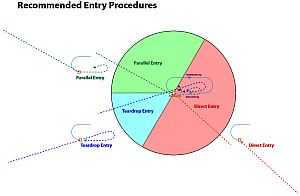VWGhiaBob
Line Up and Wait
- Joined
- Mar 17, 2013
- Messages
- 884
- Display Name
Display name:
VWGhiaBob
Direct Entry - Doesn't Make Sense?
OK...all you 90% plus and CFI'ers out there...please help a guy who's studying hard for the IFR exam.
On a teardrop entry to a holding pattern, I get that I draw a line at a 70 degree angle from my inbound course in the direction of the holding pattern and use that to determine my pattern entry method (teardrop, parallel, direct).
I find that understanding the "why" of things helps me understand them better. So...here's my question. At its extreme, a direct entry requires just under a 110 degree turn AT THE FIX, followed by a quick standard rate 180 degree turn to join the outbound leg.
Why do we not draw the line at 90 degrees so that at the extreme, we never have to make this sharp succession of turns? Isn't it hard to do a direct entry when you have to turn sharp and fast >90 degrees to join the inbound?
I apologize in advance if this is a dumb question. I'm just getting started with all this complex stuff. There sure is a lot to learn for IFR!
OK...all you 90% plus and CFI'ers out there...please help a guy who's studying hard for the IFR exam.
On a teardrop entry to a holding pattern, I get that I draw a line at a 70 degree angle from my inbound course in the direction of the holding pattern and use that to determine my pattern entry method (teardrop, parallel, direct).
I find that understanding the "why" of things helps me understand them better. So...here's my question. At its extreme, a direct entry requires just under a 110 degree turn AT THE FIX, followed by a quick standard rate 180 degree turn to join the outbound leg.
Why do we not draw the line at 90 degrees so that at the extreme, we never have to make this sharp succession of turns? Isn't it hard to do a direct entry when you have to turn sharp and fast >90 degrees to join the inbound?
I apologize in advance if this is a dumb question. I'm just getting started with all this complex stuff. There sure is a lot to learn for IFR!
Last edited:

